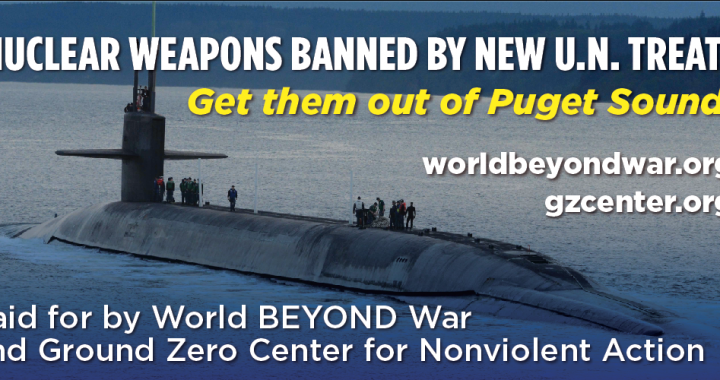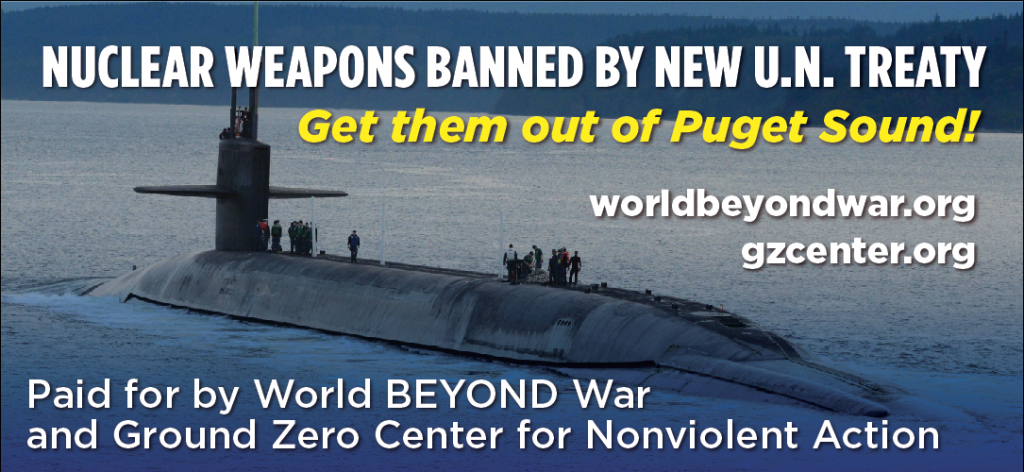Beginning January 22nd, four billboards around Puget Sound will display the following paid public service announcement (PSA): NUCLEAR WEAPONS BANNED BY NEW U.N. TREATY; Get them out of Puget Sound! Included in the advertisement is a U.S. Navy photo of the Trident submarine USS Henry M. Jackson returning to port following a routine strategic deterrent patrol.
The ad seeks to inform citizens in the Puget Sound region of the pending entry into force of the Treaty on the Prohibition of Nuclear Weapons (TPNW), and also asks citizens to accept their role and responsibility – as taxpayers, as members of a democratic society, and as neighbors to the Trident nuclear submarine base in Hood Canal – to work to prevent the use of nuclear weapons.
The four billboards will be located in Seattle, Tacoma, and Port Orchard, and are a collaboration between, and are being paid for by, Ground Zero Center for Nonviolent Action and World Beyond War.
The Ban Treaty
The TPNW enters into force on January 22nd. The treaty outlaws not only the use of nuclear weapons, but everything to do with nuclear weapons–making it illegal under international law for participating countries to “develop, test, produce, manufacture, otherwise acquire, possess, or stockpile nuclear weapons or other nuclear explosive devices.”
While the treaty’s prohibitions are legally binding only in the countries (51 so far) that become “States Parties” to the treaty, those prohibitions go beyond just the activities of governments. Article 1(e) of the treaty prohibits States Parties from assisting “anyone” engaged in any of those prohibited activities, including private companies and individuals who may be involved in the nuclear weapons business.
More countries will be joining the TPNW in the coming months and years, and the pressure on private companies involved in the nuclear weapons business will continue to grow. These companies are already facing public and financial pressures not only from States Parties, but also from within their own countries. Two of the five largest pension funds in the world have divested from nuclear weapons, and other financial institutions are following their example.
Nuclear weapons still exist largely because the companies involved in the business wield such enormous power over government policies and decision-making, especially in the United States. They are among the largest donors to congressional re-election campaigns. They spend millions of dollars on lobbyists in Washington, D.C.
U.S. policy towards nuclear weapons will change when those companies involved with nuclear weapons start to feel real pressure from the TPNW and realize that their own futures depend on diversifying their activities away from nuclear weapons.
Naval Base Kitsap-Bangor is located a few miles from the cities of Silverdale and Poulsbo and is homeport to the largest concentration of deployed nuclear weapons in the U. S. The nuclear warheads are deployed on Trident D-5 missiles on SSBN submarines and are stored in an underground nuclear weapons storage facility on the base.
Our proximity to the largest number of deployed nuclear weapons demands a deeper reflection and response to the threat of nuclear war.
The Trident Nuclear Weapon System
There are eight Trident SSBN submarines deployed at Bangor. Six Trident SSBN submarines are deployed on the East Coast at Kings Bay, Georgia.
One Trident submarine carries the destructive force of over 1,200 Hiroshima bombs (the Hiroshima bomb was 15 kilotons).
Each Trident submarine was originally equipped for 24 Trident missiles. In 2015-2017 four missile tubes were deactivated on each submarine as a result of the New START Treaty. Currently, each Trident submarine deploys with 20 D-5 missiles and about 90 nuclear warheads (an average of 4-5 warheads per missile). The warheads are either the W76-1 90-kiloton or W88 455-kiloton warheads.
The Navy in early 2020 started deploying the new W76-2 low-yield warhead (approximately eight kilotons) on select ballistic submarine missiles at Bangor (following initial deployment in the Atlantic in December 2019). The warhead was deployed to deter Russian first use of tactical nuclear weapons, dangerously creating a lower threshold for the use of U.S. strategic nuclear weapons.
Any use of nuclear weapons against another nuclear weapon state would likely elicit a response with nuclear weapons, causing overwhelming death and destruction. Besides the direct effects on the adversaries, the associated radioactive fallout would affect people in other nations. The global human and economic impacts would be far beyond imagination, and orders of magnitude beyond the effects of the coronavirus pandemic.
Hans M. Kristensen is the expert source for the statement, “Naval Base Kitsap-Bangor… with largest concentration of deployed nuclear weapons in the U.S.” (See cited source material here and here.) Mr. Kristensen is director of the Nuclear Information Project at the Federation of American Scientists where he provides the public with analysis and background information about the status of nuclear forces and the role of nuclear weapons.
The billboards are an effort by Ground Zero Center for Nonviolent Action, a grass roots organization in Poulsbo, Washington, to reawaken public awareness of the dangers of nuclear weapons in the Puget Sound region.
Civic responsibility and nuclear weapons
Our proximity to the largest number of deployed strategic nuclear weapons puts us near a dangerous local and international threat. When citizens become aware of their role in the prospect of nuclear war, or the risk of a nuclear accident, the issue is no longer an abstraction. Our proximity to Bangor demands a deeper response.
Citizens in a democracy also have responsibilities – which include choosing our leaders and staying informed about what our government is doing. The submarine base at Bangor is 20 miles from downtown Seattle, yet only a small percentage of citizens in our region know that Naval Base Kitsap-Bangor exists.
Citizens of Washington State consistently elect governmental officials who support nuclear weapons in Washington State. In the 1970s, Senator Henry Jackson convinced the Pentagon to locate the Trident submarine base on the Hood Canal, while Senator Warren Magnuson obtained funding for roads and other impacts caused by the Trident base. The only Trident submarine to be named after a person (and our former Washington State Senator) is the USS Henry M. Jackson (SSBN-730), home-ported at Naval Base Kitsap-Bangor.
In 2012, Washington State established the Washington Military Alliance (WMA), strongly promoted by both Governor’s Gregoire and Inslee. The WMA, Department of Defense, and other governmental agencies work to strengthen the role of Washington State as a “…Power Projection Platform (Strategic Ports, Rail, Roads, and Airports) [with] the complementary air, land, and sea units with which to accomplish the mission.” Also see “power projection.”
Naval Base Kitsap-Bangor and the Trident submarine system have evolved since the first Trident submarine arrived in August 1982. The base has upgraded to a much larger D-5 missile with a larger W88 (455 kiloton) warhead, with ongoing modernization of missile guidance and control systems. The Navy has recently deployed the smaller W76-2 “low-yield” or tactical nuclear weapon (approximately eight kilotons) on select ballistic submarine missiles at Bangor, dangerously creating a lower threshold for the use of nuclear weapons.
The issues
-
The U.S. is spending more on nuclear weapons programs than during the height of the Cold War.
-
The U.S. currently plans to spend an estimated $1.7 trillion over 30 years for rebuilding the nation’s nuclear facilities and modernizing nuclear weapons.
-
The New York Times reported that the U. S., Russia and China are aggressively pursuing a new generation of smaller and less destructive nuclear weapons. The buildups threaten to revive a Cold War-era arms race and unsettle the balance of power among nations.
-
The U.S. Navy states that SSBN submarines on patrol provide the U.S. with its “most survivable and enduring nuclear strike capability.” However, SSBNs in port and nuclear warheads stored at SWFPAC are likely a first target in a nuclear war. Google imagery from 2018 shows three SSBN submarines on the Hood Canal waterfront.
-
An accident involving nuclear weapons occurred on November 2003 when a ladder penetrated a nuclear nosecone during a routine missile offloading at the Explosives Handling Wharf at Bangor. All missile-handling operations at SWFPAC were stopped for nine weeks until Bangor could be re-certified for handling nuclear weapons. Three top commanders were fired, but the public was never informed until information was leaked to the media in March 2004.
-
Public responses from governmental officials to the 2003 missile accident were generally in the form of surprise and disappointment.
-
Due to ongoing modernization and maintenance programs for warheads at Bangor, nuclear warheads are routinely shipped in unmarked trucks between the Department of Energy Pantex Plant near Amarillo, Texas and the Bangor base. Unlike the Navy at Bangor, the DOE actively promotes emergency preparedness.
The Billboard Ads
The four billboard ads will be displayed from January 18th through February 14th, and measure 10 ft. 6 in. tall by 22 ft. 9 in. in length. The billboards are near the following locations:
- Port Orchard: State Highway 16, 300 feet south of State Highway 3
- Seattle: Aurora Avenue North, South of N 41st Street
- Seattle: Denny Way, East of Taylor Avenue North
- Tacoma: Pacific Avenue, 90 feet south of 129th. St. East
The photo of the submarine in the ad is from a U.S. Navy DVIDS website, at https://www.dvidshub.net/image/1926528/uss-henry-m-jackson-returns-patrol. The caption for the photo states:
BANGOR, Wash. (May 5, 2015) USS Henry M. Jackson (SSBN 730) sails home to Naval Base Kitsap-Bangor following a routine strategic deterrent patrol. Jackson is one of eight ballistic missile submarines stationed at the base providing the survivable leg of the strategic deterrence triad for the United States. (U.S. Navy photo by Lt. Cmdr. Brian Badura/Released)
Nuclear weapons and resistance
In the 1970s and 1980s, thousands demonstrated against nuclear weapons at the Bangor base and hundreds were arrested. Seattle Archbishop Hunthausen had proclaimed the Bangor submarine base the “Auschwitz of Puget Sound” and in 1982 began to withhold half of his federal taxes in protest of “our nation’s continuing involvement in the race for nuclear arms supremacy.”
One Trident SSBN submarine at Bangor is estimated to carry about 90 nuclear warheads. The W76 and W88 warheads at Bangor are equal respectively to 90 kilotons and 455 kilotons of TNT in destructive force. One submarine deployed at Bangor is equal to more than 1,200 Hiroshima-sized nuclear bombs.
On May 27, 2016, President Obama spoke in Hiroshima and called for an end to nuclear weapons. He said that the nuclear powers “…must have the courage to escape the logic of fear, and pursue a world without them.” Obama added, “We must change our mindset about war itself.”





